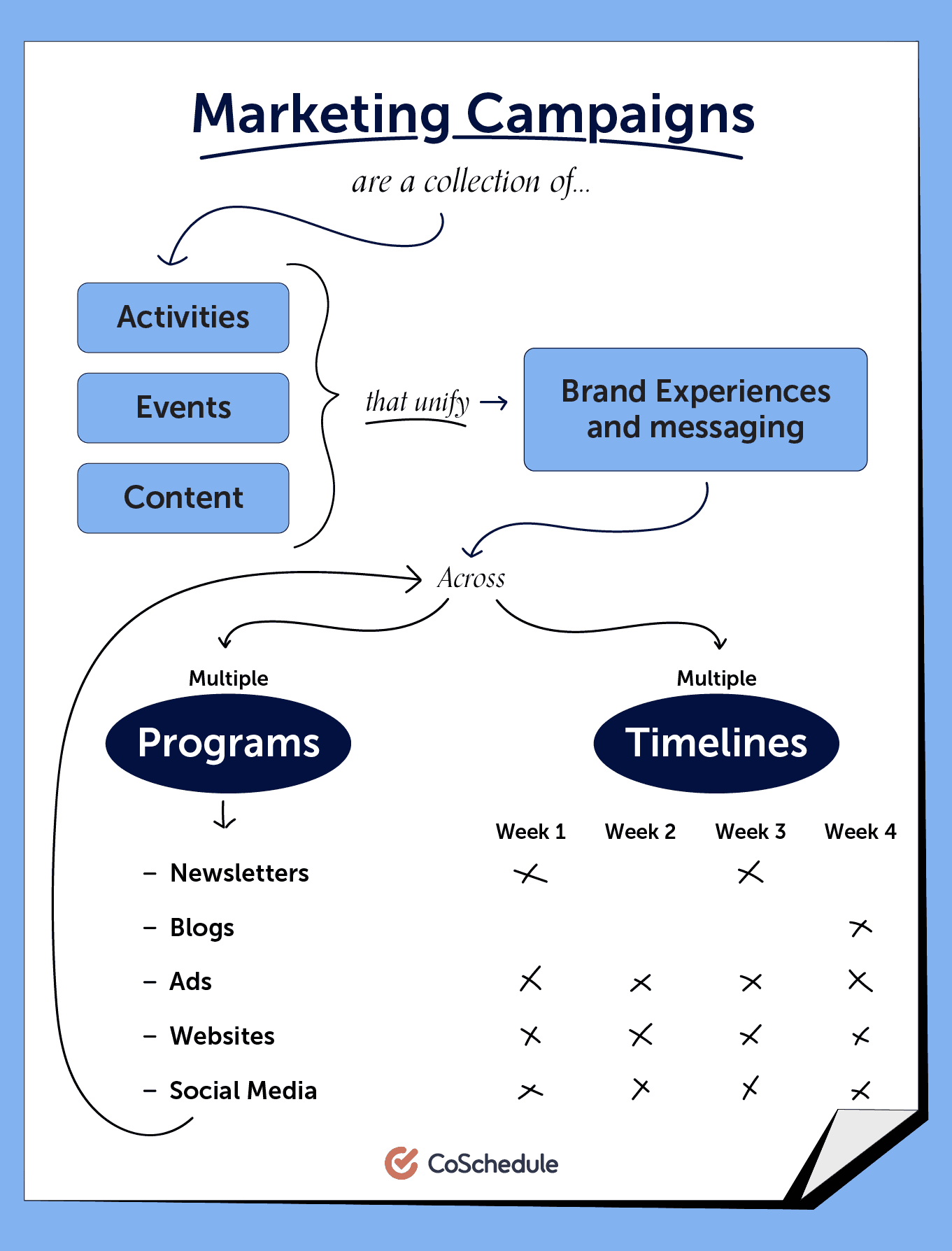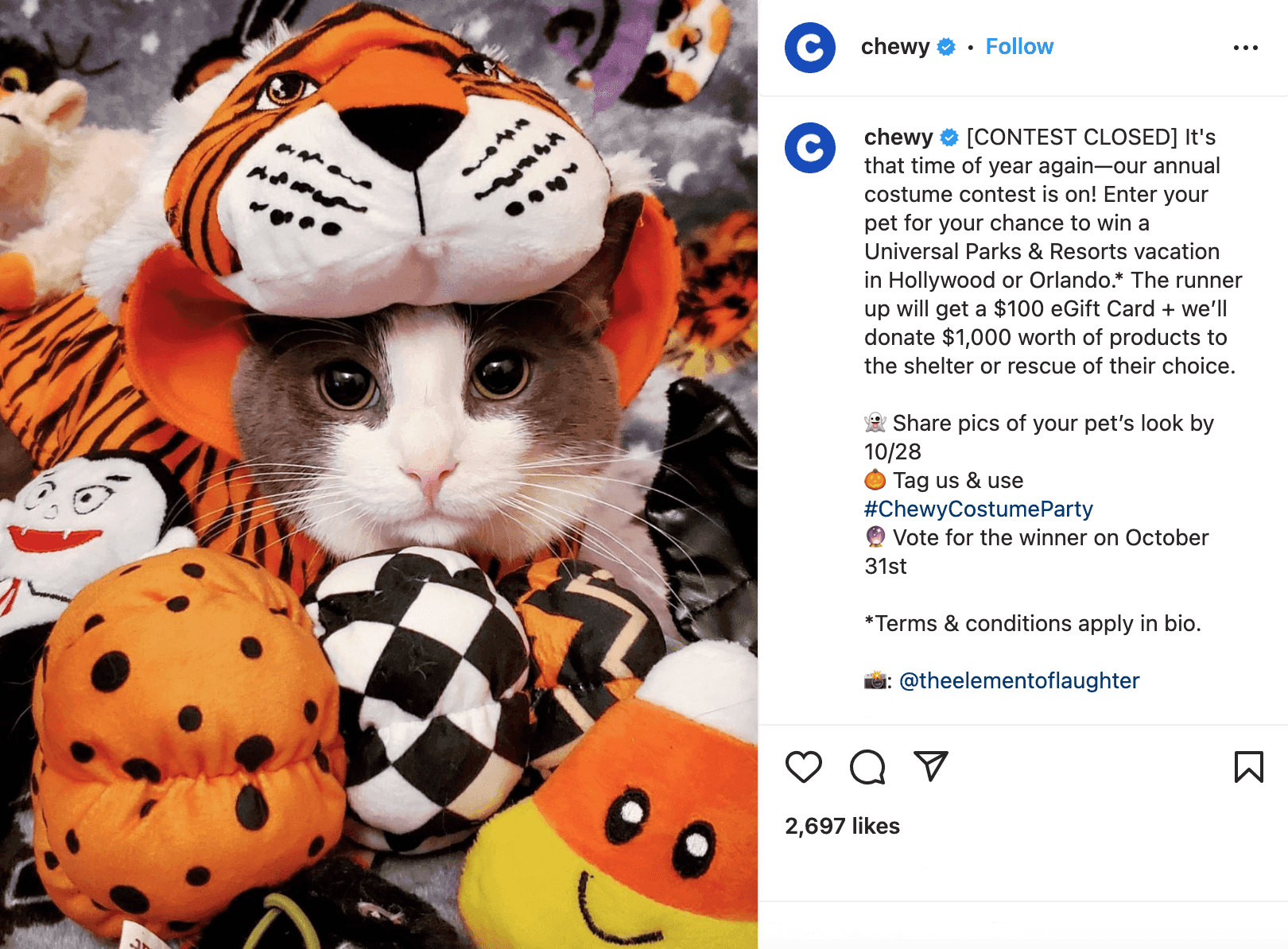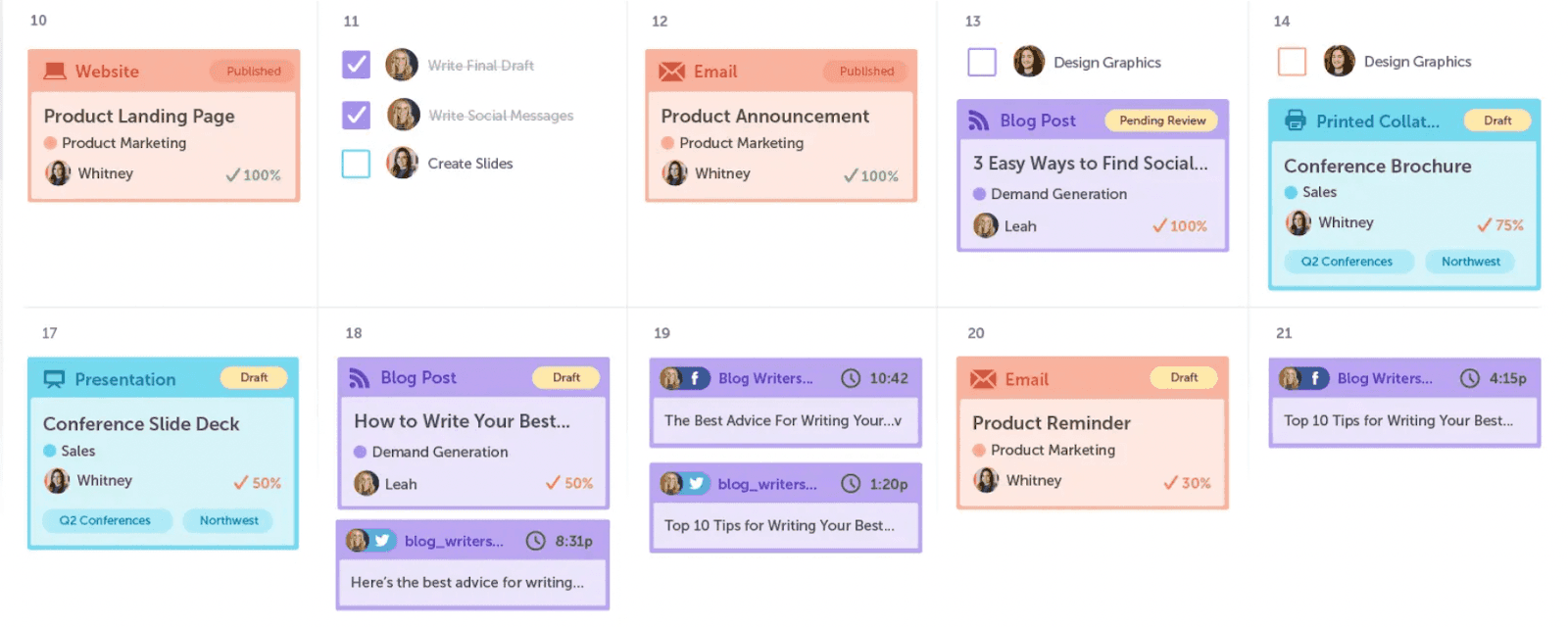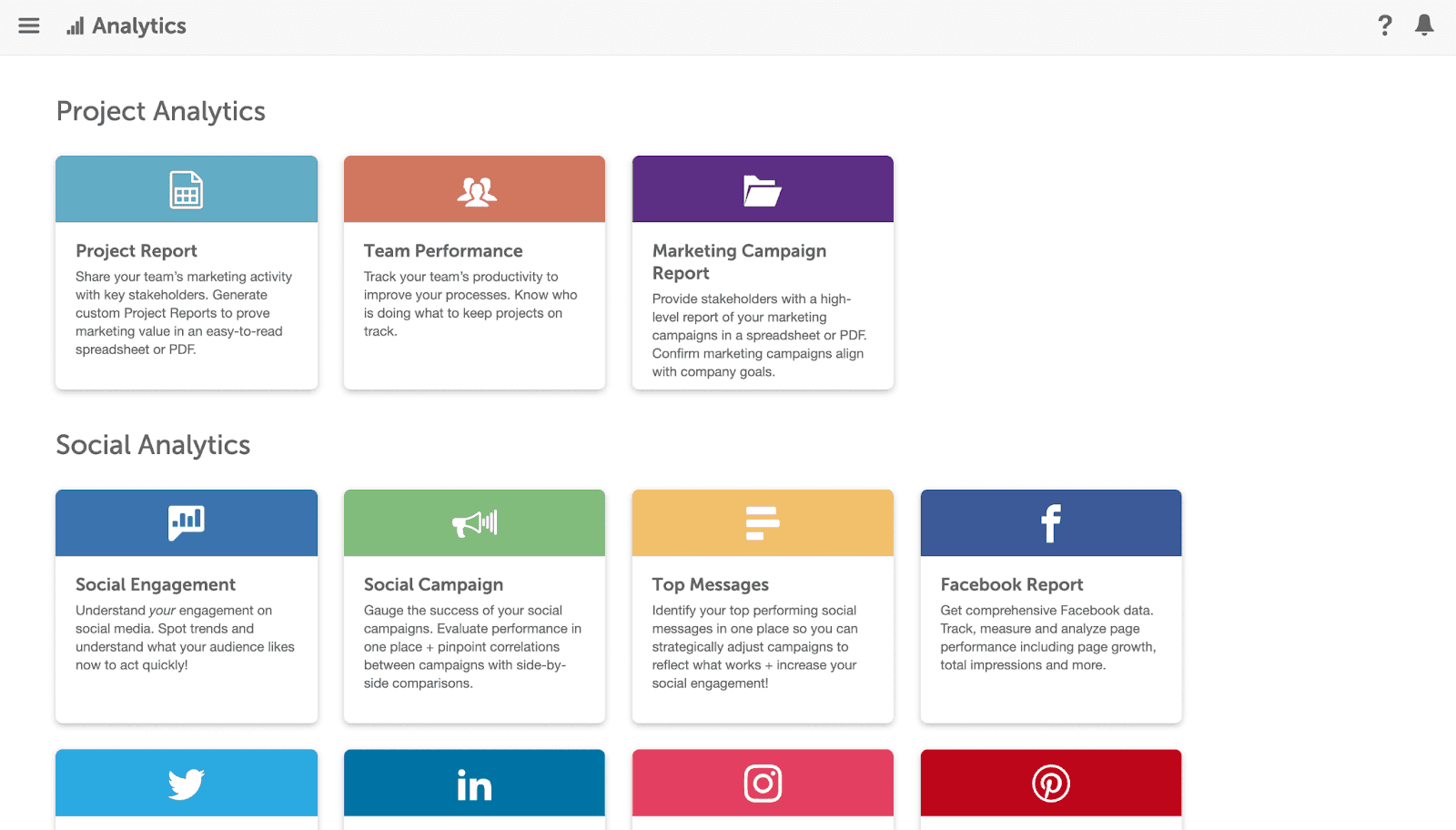Effective marketing campaign management is crucial for the success of all marketing campaigns. Without it, you’ll likely have an unorganized campaign plan with a poor understanding of the audience you want to reach, the marketing tactics you want to execute, and the channels you want to use.
In this guide, let’s walk you through the exact steps to creating a winning marketing campaign management strategy, including the role campaign managers play and the importance of campaign management.
What Are Marketing Campaigns?
Marketing campaigns are a collection of activities, events, and content that unify brand experiences and messaging across multiple marketing programs over defined timelines to achieve a specific goal.
An example of a marketing campaign is a product launch initiative that communicates a unified message leveraging multiple marketing programs (tactics, channels, and content).
- Recurring weekly email newsletters
- Content marketing blogs
- Search engine marketing paid ads
- Multiple marketing projects, such as a press release, email blast, and video

What Is Marketing Campaign Management?
Marketing campaign management communicates a single message and creates a unified marketing experience by planning, executing, tracking, and analyzing projects across multiple tactics, channels, and types of content to achieve a specific goal.
Why Is Marketing Campaign Management Important?
From ensuring all campaigns and tasks are planned, to optimizing all campaign content to reflect the same unified message, marketing campaign management has numerous advantages. Marketers who proactively plan their marketing campaigns are 331% more likely to report success than their peers who don’t.
Let’s unpack the benefits of marketing campaign management below:
- Ensure the entire campaign communicates the same message effectively. Marketing campaign management includes planning, documenting, and helping execute the same audience-resonating message across various campaign channels, content types, and tactics.
- Create a unified marketing experience. Marketing campaign management involves mapping out the target audience’s various touchpoints with your brand across different channels. Doing so helps deliver a uniform and memorable experience throughout the campaign.
- Oversee campaign content production. Marketing campaign management includes breaking down all the work that goes into each campaign, then assigning it to different team members. This helps guarantee no task falls through the cracks, and that everything gets completed using a defined schedule.
- Drive better results. Since campaign management centers around planning and executing audience-engaging campaigns in an organized manner, it ensures campaigns run smoothly and communicate a unified message. This systematic approach also increases your odds of success, as organized marketers are 674% more likely to report success than their unorganized peers. Moreover, better planning and subsequent execution save from budget wastage and help drive a better campaign ROI.
What Does A Marketing Campaign Manager Do?
Broadly, a marketing campaign manager is responsible for planning, coordinating, executing, and tracking campaign results.
For example, a marketing campaign manager working on a launch campaign for a new product will plan exactly what marketing tactics she’ll use to market the latest product and which marketing channels she’ll use.
She’ll then devise a strategy mapping out the campaign’s message, objectives, and KPIs, how she’ll position the product for its customer, and break down all the tasks involved in the campaign. At this point, the manager will also document her plans so she can coordinate with her team better and explain her ideas to stakeholders.
From there, the marketing campaign manager will focus on getting things done by assigning tasks to different teammates or seeking external help from contractors. She’ll also track progress and review the completed work to ensure all marketing collateral communicates the campaign’s core message and reflects the brand’s voice.
And finally, the manager will launch the campaign — ensuring everything goes smoothly and as planned. She’ll close with tracking the results the campaign delivers.
All in all, any marketing campaign manager is responsible for the following:
- Plan each step of the marketing campaign, including laying out various touchpoints and the desired unified message.
- Coordinate with other teams such as sales, freelancers, and customer support to create and launch high ROI-driving marketing campaigns.
- Execute the campaign. Assign tasks involved, make sure nothing’s missed, schedule work, and review completed work for unified messaging.
- Track results and reflect on what went well and what needs improvement in future campaigns.
Types Of Marketing Campaigns
Now for the different types of marketing campaigns a marketing campaign manager handles:
Social Media Marketing Campaign
Such a campaign leverages social media to reach its target audience using different channel-specific content formats.
Chewy, for example, uses Instagram to connect with and sell to its audience. To this end, the pet food and accessories retailer hosts giveaways and AMA sessions with expert vets to answer their audience’s questions about their pets.

They also post engagement-driving Stories that poll their audience, ask them questions, and more. Lastly, the eCommerce store posts high-quality pictures on its Instagram account to showcase products, make announcements, and share user-generated content (UGC).
Email Marketing Campaign
This campaign uses email as a channel to reach, engage, and convert customers — even keep in touch with customers to encourage them to buy again from you.
It’s one of the most effective channels, given that each $1 spent on email marketing is estimated to deliver a $36 return.
Take it from the read-it-later app, Pocket. It uses email to engage users by curating quality pieces from across the web for readers.

Content Marketing Campaign
Content marketing involves creating different content types to move your target audience through various marketing funnel stages (awareness, consideration, and purchase).
Examples of content you can create include infographics, industry reports, interactive quizzes, and blog posts, to name a few. Case in point: Grammarly makes helpful blog content for their target audience — covering topics like grammar basics, writing tips, and grammar rules.
 Product Marketing Campaign
Product Marketing Campaign
Product marketing introduces a new product or new product feature to the market. Its success, however, centers around how well a campaign manager positions the new product or features for their customers.
An inspiring example of such a campaign is Jones Road Beauty’s launch of their ‘What The Foundation.’ They’ve positioned their product as a lightweight foundation that “looks like your skin on its best day.” The product also aligns with the brand’s central value of clean, minimal makeup.
Here’s an example of the brand sharing UGC on their Instagram to educate their followers about the foundation:

Brand Marketing Campaign
Lastly, a brand marketing campaign focuses on creating a brand image for a business. It works to create awareness about a business’s back story and the values it stands for. Such a campaign creates awareness about the brand and, eventually, recognition and loyalty among its customers.
Dove’s marketing is an excellent example of this. Its brand marketing campaigns show that the hair and skin care brand stands for inclusivity and inspires confidence in women so they feel comfortable in their own skin.
This video on Real Beauty Sketches reflects these brand values that Dove stands for:
How To Create A Marketing Campaign Management Strategy
With the basics out of the way, let’s walk you through the 6 steps to create a marketing campaign management strategy:
1. Establish Goals, Objectives, & KPIs
A solid starting point is setting goals for your marketing campaign, as goals give you clarity and a well-defined direction for the marketing tactics to use and KPIs to measure.
Goal setting also increases your odds of success as our research reveals marketers who set goals are 376% more likely to report success than those who don’t set goals. The best part? Goal-setting marketers achieve 70% of the goals they create.
Some ideas for marketing goals to set include:
- Increasing sales
- Growing an email list
- Entering new markets
- Raising more revenue
- Increasing website traffic
- Growing brand awareness
- Expanding marketing share
If you’re struggling, use the following goal-setting framework to get the ball rolling:
By {insert day, month, year}, the {insert your organization’s name} marketing team will reach {insert number} {insert metric} every {insert time frame}.
After you’ve set actionable and realistic goals, create objectives and KPIs for the campaign. Objectives help guide strategy creation, whereas KPIs make tracking campaign progress and results easy. So you must have all three (goals, objectives, and KPIs) ready before you take the next step.
2. Set A Budget
Begin budget planning by creating a cost estimate for each goal you’ve set.
Use data from previous campaigns to guide cost estimation. Don’t have any past campaign data? Refer to industry averages for estimates.
Once done, create a spending plan — how much will you allocate to each marketing tactic, channel, and task?
For a content marketing campaign, map out the tasks involved and how much money you’d need to complete them. For example, you could allot $950 for each blog post and $5,500 to enlist an SEO agency’s help to rank your content.
To create realistic spending plans per campaign, make sure you collaborate with marketing team leaders such as the content strategist and social media marketing lead. You can ask them to propose a campaign budget or work closely with them to create one.
Next, coordinate with finance and executive teams to get the budget approved.
3. Define Your Audience Segmentation
With your goals, objectives, and budget ready, answer the following question: who is your target audience for the campaign?
Some of the folks that you’re targeting may be your customers already. Others might have only just heard about you. Whatever the case, breaking your audience into subgroups helps you tailor your campaign’s messaging to the audience’s exact needs. In turn, this makes your marketing more effective than when you blast a generic message that may only lightly touch on its target audience’s struggles.
Here are some subgroups you can use to segment your audience:
- Engagement level; for instance, divide your audience into regular and new customers
- Demographics such as gender identity, geographic location, age, and education level
- Behavior, for example, those looking to buy immediately and those who aren’t problem aware yet
4. Plan Your Marketing Mix
Now that you know your target audience, answer the 7Ps of marketing based on their needs and preferences.
You’ll need to work on the following Ps:
- Product. Identify how you’ll position the product you’re marketing.
- Price. Plan how you’ll justify your pricing to encourage customers to buy from you, including any discount codes to offer.
- Place. Find out the marketing channels your target audience uses so you can tap into them for product and content distribution. For retailers with physical stores, this also includes taking care of shipping and logistics.
- Promotion. Outline which marketing tactics you’ll use to promote your product and achieve the marketing objectives you’ve set.
- Packaging. This is specifically useful for DTC stores for delivering products in a customer-appealing manner.
- Positioning. Layout exactly how you’ll position the brand you’re marketing — is it a cost-effective solution or a premium investment?
- People. Create a team plan for who will be responsible for what. For instance, who will write email newsletters, answer customers’ questions, and so on. If you already have a strong team working with you, all you’ll need to do is to get them up to speed with the new marketing campaign’s objectives and responsibilities, along with the schedule they’ll follow.
5. Create Compelling Content
Before you can get into content creation, create channel-specific marketing strategies for each of the marketing channels you shortlisted in the step above.
The idea is simple: create content based on each channel’s requirements and audience expectations.
Make sure you document each channel’s marketing strategy and content requirements so you can quickly brief your team on the content to create.
One last thing: map out offers or call to action (CTAs) for each content piece. These CTAs will help you effectively achieve your campaign objectives.
Enhance your brand messaging—explore our Free Slogan Generator.
Recommended Reading: Top Content Creation Tools Every Marketer Needs
6. Measure Results
Last step: measure progress and results by studying the KPIs you identified in the first step.
You’ll want to set up a performance dashboard or use marketing campaign software that summarizes results to make this step easy.
As you study results, make sure to note what’s resonating with your audience, the marketing elements that are helping drive results, and what needs to be done differently in future campaigns.
Benefits Of Marketing Campaign Management Software
Finally, as we wrap this up, let’s look at ways using a marketing campaign management tool can help you plan, organize, manage, and analyze marketing campaigns:
Ability To Schedule Marketing Campaigns
Software helps you stay on top of the campaign — never missing a due date in your campaign schedule. Most of all, scheduling marketing campaign content allows you to be consistent with your marketing, which is crucial for success.
Using CoSchedule Marketing Calendar, for example, you can lay out your entire campaign plan in a calendar and create and schedule social posts from the same platform.

Team Collaboration
A marketing campaign software such as CoSchedule lets you assign work to different team members, answer questions about the campaign, and share feedback on their work — all in one central platform.

Multichannel Marketing Automation
By allowing you to automate processes on different marketing channels from one place, a marketing management tool helps reduce the work on your plate. It also assists you in staying on track with your marketing calendar. With CoSchedule, for example, you can automate social posts, email, and web marketing.
Easy To Use
Because a campaign management platform like CoSchedule has a drag-and-drop interface, it is easy to use. This makes it simple to use for not only the campaign manager but also the rest of the team.

Better Campaign Organization
You can streamline campaign workflow and team communication by using marketing campaign management software to plan and create content for various campaigns in one place. Using this helps you organize the campaign better, create results-driving content, get a bird’s eye view of the work, and ensure nothing slips through the cracks.
Access Campaign Analytics
Lastly, use your campaign management platform to see campaign results in easy-to-understand charts. Not only does this make it easy to track progress, but it also simplifies sharing campaign results with stakeholders.

